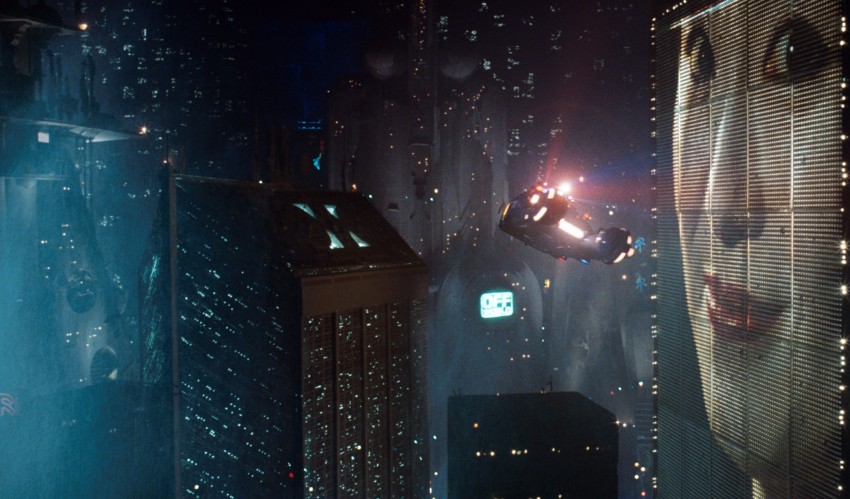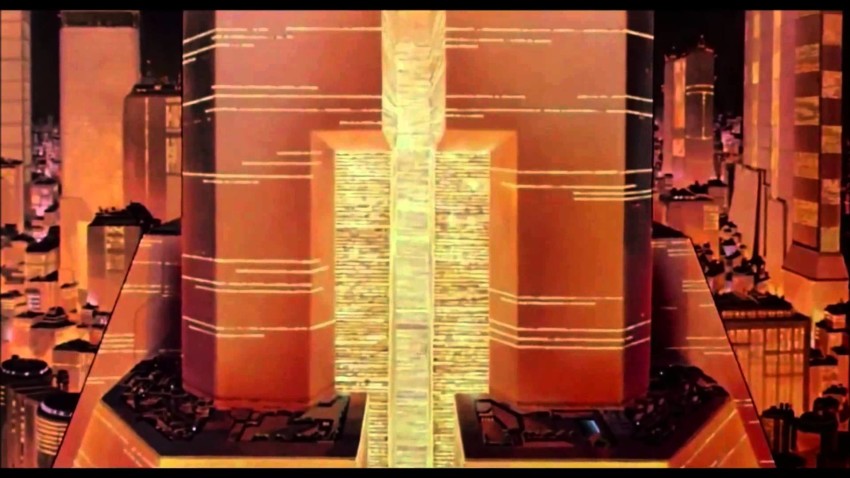Blade Runner & Anime
February 20, 2018 · 0 comments
By Raz Greenberg.
 Ridley Scott’s Blade Runner, a cinematic adaptation of a novel by Philip K. Dick about a bounty hunter on a mission to eliminate androids, debuted in 1982 and forever changed the way we think of the future. While the dystopian cinema of the 1970s gave us its share of dirty and polluted landscapes, Blade Runner fused these landscapes with beautiful high-tech gadgets and vehicles and imposing architecture. This combination of expansive technology and poor living conditions later solidified into the science fiction subgenre known as cyberpunk – in fact, while writing the genre’s seminal novel Neuromancer (1984), author William Gibson initially felt devastated watching Blade Runner, as he thought that Ridley Scott was ahead of him in shaping the futuristic world image that he had in mind for his book.
Ridley Scott’s Blade Runner, a cinematic adaptation of a novel by Philip K. Dick about a bounty hunter on a mission to eliminate androids, debuted in 1982 and forever changed the way we think of the future. While the dystopian cinema of the 1970s gave us its share of dirty and polluted landscapes, Blade Runner fused these landscapes with beautiful high-tech gadgets and vehicles and imposing architecture. This combination of expansive technology and poor living conditions later solidified into the science fiction subgenre known as cyberpunk – in fact, while writing the genre’s seminal novel Neuromancer (1984), author William Gibson initially felt devastated watching Blade Runner, as he thought that Ridley Scott was ahead of him in shaping the futuristic world image that he had in mind for his book.
Japan, and the anime and gaming industries in particular, were particularly eager to follow in the footsteps of Scott’s film. Thematic similarities can be found in acclaimed works as Mamoru Oshii’s Ghost in the Shell (1995), but even more significant are the cases of blatant rip-offs loving pastiches as the original Bubblegum Crisis series (1987) or Hideo Kojima’s adventure game Snatcher (1988) – the former borrowing names and concepts from Blade Runner to create a superhero adventure, the latter doing the same while applying more of a monster-movie vibe.
But weren’t the futuristic landscapes of Blade Runner indicating of a strong Japanese and Asian influence to begin with? The film presents us with a future in which the streets of Los Angeles are shaped by the presence of Asian immigrants, as reflected in culture and language. Paired with the film’s vision of big-business running everything, this reminded some of the atmosphere of Tokyo and Hong Kong. But Syd Mead, the designer of Blade Runner‘s futuristic scenery and props, denied such influence; while he did visit both Tokyo and Hong Kong during the 1950s and the 1960s, he claims that at the time the urban environment of both cities was very different from the one of the 1980s, and that the main inspiration for the urban design of Blade Runner came from New York and Chicago of the same decade. There is no reason to doubt Mead on the matter, since he had no problem admitting a Japanese influence in other cases (in the wonderful documentary Visual Futurist he described how he visited Japanese robot factories while working on the designs for the 1986 robot comedy Short Circuit). Mead himself has achieved something of an iconic status in Japan following his work on Blade Runner – not only was he invited to work for commercial clients, but he was also hired by anime production companies to do designs for leading franchises, working on Yamato 2520 (Yoshinobu Nishizaki’s ill-fated attempt to restart the Yamato franchise in 1994) and Turn-A Gundam. Even today, when Japanese artists and animators regularly work on American superhero franchises in comics and animation, this is a remarkable achievement, the equivalent of inviting a Japanese designer to work on redesigning the USS Enterprise or the Millennium Falcon.
 As well as the iconic Metropolis, Blade Runner also drew influence from the same source that inspired major figures in the world of manga and anime. One key visual inspiration for the film cited by Ridley Scott was the French comics magazine Metal Hurlant (known in its English edition as Heavy Metal), founded in 1974. The magazine broke new ground for sophisticated science fiction and fantasy graphic stories, alongside taboos on sex and violence, and in 1975 ran the short story The Long Tomorrow. Written by American screenwriter Dan O’Bannon and drawn by the magazine co-founder Jean “Moebius” Giraud, the story follows an unimaginably detailed futuristic city where a down-on-his-luck private detective takes on a seemingly simple job, and gets in trouble.
As well as the iconic Metropolis, Blade Runner also drew influence from the same source that inspired major figures in the world of manga and anime. One key visual inspiration for the film cited by Ridley Scott was the French comics magazine Metal Hurlant (known in its English edition as Heavy Metal), founded in 1974. The magazine broke new ground for sophisticated science fiction and fantasy graphic stories, alongside taboos on sex and violence, and in 1975 ran the short story The Long Tomorrow. Written by American screenwriter Dan O’Bannon and drawn by the magazine co-founder Jean “Moebius” Giraud, the story follows an unimaginably detailed futuristic city where a down-on-his-luck private detective takes on a seemingly simple job, and gets in trouble.
Packing an incredible amount of narrative and graphic detail into its 16 pages, The Long Tomorrow had a huge influence on Blade Runner in both its grim and futuristic urban vision and its story: the subplot about illegal infiltration to Earth, the contrasts between gigantic structures of the rich and powerful and poverty on the streets and pretty much everyone’s sense of fashion has made it intact from the pages of Metal Hurlant to Scott’s film. Scott was not the only one who found inspiration in the pages of the French magazine: people in Japan also took notice, notably a young manga artist named Katsuhiro Otomo. Otomo fully admitted that Giraud’s style had a huge influence on him, and the inspiration drawn from the French artist’s science fiction works as The Long Tomorrow is obvious when reading Otomo’s stories in the genre as Fireball and his magnum-opus Akira, with the latter being the place where the Blade Runner connection becomes obvious: while the original Akira manga drew its inspiration from The Long Tomorrow‘s gritty futuristic urbanism, the 1988 anime film adaptation added the more flashy and attractive bits of futuristic technology (notably the holographic advertisements), inspired by Scott’s film.
 With this year’s release of Blade Runner 2049, the sequel to the original film, the Blade Runner universe and the anime world met again as Japanese director Shinichiro Watanabe was brought to helm Black Out 2022 a short animated prequel to the new film. In many ways, the film brings the relationship between the anime industry and Blade Runner full circle: Scott’s film was obviously one of the many places where Watanabe drew inspiration from when working on his own futuristic noir Cowboy Bebop. Alas, there is something disappointing in Black Out 2022; it sticks a little too closely to the dark and grim atmosphere of the Blade Runner universe, without the visual wit that accompanied Cowboy Bebop or, for a film which revolves around an act of terrorism, the complex approach to the issue seen in Watanabe’s series Terror in Resonance. Still, it’s another fascinating example of how, 35 years after its premiere, the anime industry is perhaps the proudest representative of Blade Runner‘s legacy.
With this year’s release of Blade Runner 2049, the sequel to the original film, the Blade Runner universe and the anime world met again as Japanese director Shinichiro Watanabe was brought to helm Black Out 2022 a short animated prequel to the new film. In many ways, the film brings the relationship between the anime industry and Blade Runner full circle: Scott’s film was obviously one of the many places where Watanabe drew inspiration from when working on his own futuristic noir Cowboy Bebop. Alas, there is something disappointing in Black Out 2022; it sticks a little too closely to the dark and grim atmosphere of the Blade Runner universe, without the visual wit that accompanied Cowboy Bebop or, for a film which revolves around an act of terrorism, the complex approach to the issue seen in Watanabe’s series Terror in Resonance. Still, it’s another fascinating example of how, 35 years after its premiere, the anime industry is perhaps the proudest representative of Blade Runner‘s legacy.
Blade Runner 2049 is out on UK Blu-ray.
Leave a Reply